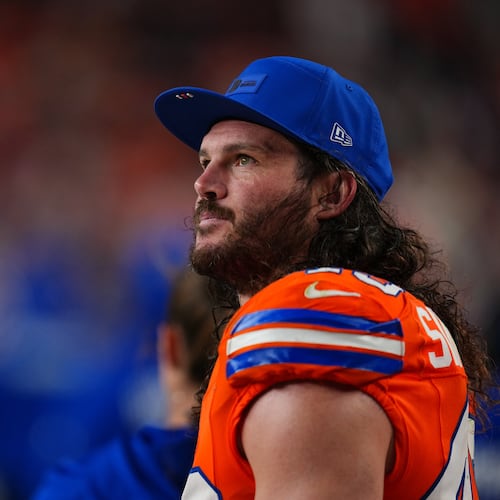In homes across the U.S. this holiday season, a familiar sound will likely be heard beneath the din of pots and pans — the crack of football helmets colliding.
A day of gratitude, Thanksgiving and the days surrounding the holiday are intertwined with watching football. One metro Atlanta couple has worked to make a game known for hard hits safer.
Erin and Lee Hanson are the founders of Guardian Sports, a soft-shell helmet cap with polygonal foam pockets that are used by players at the youth, college and professional levels to reduce the force of impacts on their heads.
Credit: Jason Getz / Jason.Getz@ajc.com
Credit: Jason Getz / Jason.Getz@ajc.com
The issue of brain injuries caused by repeated hits has become a point of emphasis for player safety. The Hansons, whose business is based in Peachtree Corners, have used their knowledge of materials science and manufacturing to create a product now seen on practice fields and gridirons across the nation.
Fans of the Georgia Bulldogs might’ve noticed defensive lineman Christen Miller wearing a Guardian Cap in UGA’s win earlier this month over the Florida Gators.
The Hansons are college sweethearts, now married for 41 years, whose path to becoming sporting goods inventors is rooted in their family. Lee Hanson is a chemical engineer from Georgia Tech, while Erin studied math and education at Georgia State University.
After Lee spent about a decade working for a chemical manufacturer, in 1996, he founded his own materials science business, the Hanson Group. But just as he quit his job and launched the company, the couple found out they were pregnant with their fifth child.
“That was a sink or swim moment. It’s like, man, we got to make this thing work,” Erin Hanson said with a laugh in an interview with The Atlanta Journal-Constitution.
For years, the Hanson Group’s primary clients were chemical giants, such as BASF, 3M and Dow Chemical. But in 2010, a group of doctors and an inventor approached the Hanson Group and said, “Hey, there’s a problem with football helmets, with all the concussions and everything else. Can you help us solve that problem?” Lee Hanson recalled.
Despite dazzling passes, runs and interceptions, football is at its heart a collision sport. Over the past few decades, a growing field of research has shown the long-term damage those hits can have on players, some of whom develop a progressive degenerative brain disease called chronic traumatic encephalopathy, or CTE.
By the time the Hanson Group was approached to develop a new type of helmet, one of the Hansons’ sons was playing football, and the couple wanted to help protect his and other children’s brains.
“It happened to be, one of our specialties was polyurethanes,” Lee Hanson said. “So we helped them skin a football helmet with a padded foam on the top of the helmet. And we took it to Manhattan … to the NFL at a conference, and it was before its time. They weren’t ready for it,” he said.
Credit: HYOSUB SHIN / AJC
Credit: HYOSUB SHIN / AJC
“It changed the sound of the game,” Erin Hanson recalled about the helmet prototype. “It made it a very soft thump, and they needed the television with that loud crack and replaying all of those hard hits.”
“So we said, how do we inexpensively retrofit every helmet out there? If we’re not going to change the helmet itself, let’s just change practice. … So we’ll do a padded shell that’s super lightweight, that’s one size fits all, that’s inexpensive, that they can use during the week in practice to take some of the impacts off of those hits and take it off for game day,” she said.
The Hanson Group developed the technology, and then the couple launched Guardian Sports as its own company to handle the marketing and manufacturing of the sporting goods products. The two sides of the Hansons’ business empire meet in the middle, literally, at their 95,000-square-foot headquarters and warehouse in Peachtree Corners.
Credit: HYOSUB SHIN / AJC
Credit: HYOSUB SHIN / AJC
Besides the Guardian Caps, the company also manufactures lacrosse balls, which are the official ball used by the professional field league in the U.S., a chin strap that uses a hydraulic system to reduce face mask-to-face mask impacts, padded headbands for flag football and an artificial turf infill.
Eventually, the NFL came around to the Guardian Cap shell model. In 2022, the league required certain positions to wear the cap during training camps and then expanded the mandate the following year to every preseason practice as well as every regular season and postseason practice with contact.
Last year, the NFL said it had found a nearly 50% reduction in concussions among players who wore Guardian Caps in the mandated sessions versus before the mandate was in place. The Virginia Tech helmet lab found in a 2024 study that helmet shells reduced concussion risk on average by 15% to 34%.
But research on the caps’ efficacy is mixed. Other studies from university researchers suggest small to no difference in specific head impact data for college football athletes wearing Guardian Caps.
“We believe the benefit of the cap is reducing impact over time of our players,” Erin Hanson said. “So if you’re taking 10%, 20%, 30% of the impact off of every single hit … it’s a cumulative (effect).”
Though the initial vision for the Guardian Cap was to reduce impact during football practice, it has since become a game-day sight. Last year, the NFL allowed players to wear Guardian Caps during games “in an effort to increase player health and safety and prevent head injuries,” the organization said in a statement at the time.
Credit: arvin.temkar@ajc.com
Credit: arvin.temkar@ajc.com
“It was an unbelievable stamp of validation,” Erin Hanson said. “The NFL, I give them a huge round of applause for investing what they are in sports safety. … And so for them to reach out and say, ‘Hey, we’re going to mandate your product,’ that was enormous. And our hope is that then that filters down to those young, developing brains.”
About the Author
Keep Reading
The Latest
Featured





